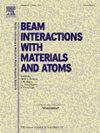HFRS分离器大功率石墨靶的原理设计
IF 1.4
3区 物理与天体物理
Q3 INSTRUMENTS & INSTRUMENTATION
Nuclear Instruments & Methods in Physics Research Section B-beam Interactions With Materials and Atoms
Pub Date : 2025-02-18
DOI:10.1016/j.nimb.2025.165650
引用次数: 0
摘要
目前,中国高强度重离子加速器设施(HIAF)正在建设新一代飞行放射性分离器——高能碎片分离器(HFRS)。为这种高强度分离器设计高功率生产目标是一项重大挑战。本文概述了靶材的物理要求,测量了石墨材料的热物性参数,利用有限元分析方法讨论了石墨盘在热学和力学方面的技术挑战,并提出了采用辐射冷却旋转石墨盘的大功率石墨靶材的原理设计。计算结果表明,对于功率为1.59 kW和沉积功率为0.58 kW的慢速提取铀束,所设计的石墨靶在热学和力学方面都是安全的。对于最大功率为9.5 kW的快速提取铀束,当石墨靶中的沉积功率为3.5 kW时,压力波传播引起的热应力是评价靶安全性的关键参数。考虑安全余量,需要将水平梁点和垂直梁点的标准差分别提高到2mm和3.8 mm,以保证热应力低于石墨材料的抗拉强度。这些结果为今后HFRS分离器目标系统的设计和运行提供了参考。本文章由计算机程序翻译,如有差异,请以英文原文为准。
Principle design of a high-power graphite target for the HFRS separator at HIAF
A new generation in-flight radioactive separator named High energy FRagment Separator (HFRS) is currently under construction at the High Intensity heavy-ion Accelerator Facility (HIAF) in China. Designing a high-power production target for this high-intensity separator is a major challenge. This paper gives an overview of the physical requirements for the target, measures the thermophysical parameters of a graphite material, discusses the technical challenges in the thermal and mechanical aspects of the graphite disk using finite element analysis, and proposes a principle design for this high-power graphite target, which employs a radiation-cooled rotating graphite disk. The calculated results show that for a slow extracted uranium beam with a power of 1.59 kW and a deposition power of 0.58 kW, the designed graphite target was safe in both thermal and mechanical respects. For a fast extracted uranium beam with a maximum power of 9.5 kW, when the deposition power in the graphite target is 3.5 kW, the thermal stress caused by the propagation of pressure waves is the key parameter in evaluating the safety of the target. Considering the safety margin, the standard deviation of the horizontal and vertical beam spot needs to be increased to 2 mm and 3.8 mm, respectively, to ensure that the thermal stress is lower than the tensile strength of the graphite material. These results provide references for the future design and operation of the target system of the HFRS separator.
求助全文
通过发布文献求助,成功后即可免费获取论文全文。
去求助
来源期刊
CiteScore
2.80
自引率
7.70%
发文量
231
审稿时长
1.9 months
期刊介绍:
Section B of Nuclear Instruments and Methods in Physics Research covers all aspects of the interaction of energetic beams with atoms, molecules and aggregate forms of matter. This includes ion beam analysis and ion beam modification of materials as well as basic data of importance for these studies. Topics of general interest include: atomic collisions in solids, particle channelling, all aspects of collision cascades, the modification of materials by energetic beams, ion implantation, irradiation - induced changes in materials, the physics and chemistry of beam interactions and the analysis of materials by all forms of energetic radiation. Modification by ion, laser and electron beams for the study of electronic materials, metals, ceramics, insulators, polymers and other important and new materials systems are included. Related studies, such as the application of ion beam analysis to biological, archaeological and geological samples as well as applications to solve problems in planetary science are also welcome. Energetic beams of interest include atomic and molecular ions, neutrons, positrons and muons, plasmas directed at surfaces, electron and photon beams, including laser treated surfaces and studies of solids by photon radiation from rotating anodes, synchrotrons, etc. In addition, the interaction between various forms of radiation and radiation-induced deposition processes are relevant.

 求助内容:
求助内容: 应助结果提醒方式:
应助结果提醒方式:


